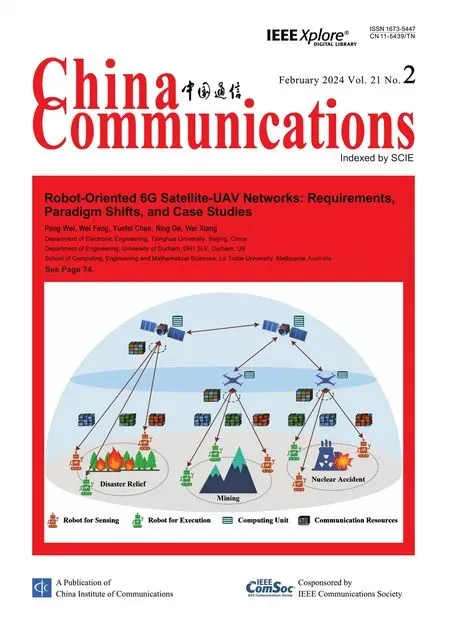Resilient Satellite Communication Networks Towards Highly Dynamic and Highly Reliable Transmission

Lidong Zhu
As the key infrastructure of space-ground integrated information networks,satellite communication networks provide high-speed and reliable information transmission.In order to meet the burgeoning service demands of the IoT and the Internet,the low-latency LEO satellite network has developed rapidly.However,LEO satellites face inherent problems such as small coverage,fast moving speed and short overhead time,which will be more severe when serving high-dynamic users,e.g.high-speed rails and airplanes.The heterogeneous network composed of GEO,MEO and LEO satellites can provide various services,whose network management and resource allocation are also more challenging.
High-speed relative movement between satellites and satellites or between satellites and users,will cause large frequency deviations,weak links and other phenomena that deteriorate transmission reliability,resulting in a decline in the on-demand service capability of satellite communications.On the other hand,the rapid increase in the number of satellites and the shortage of spectrum resources make the co-frequency interference of inter-satellite and satellite-ground be further prominent.It is also important to ensure transmission reliability since satellite are susceptible to various interference.Resilient satellite communication networks jointly utilizes multi-orbit,multi-function,multi-system satellites to guarantee that users can seamlessly switch to another satellite system and different frequency to improve the flexibility of communication,which brings new solutions to these difficulties.
The resilient satellite communication network could include various satellite systems such as communication,navigation and remote sensing.It utilizes the positioning and tracking capabilities to effective improve communication quality and efficiency.Users can dynamically share the resources of other satellite systems when they suffer from poor service quality.However,in order to achieve a resilient satellite communication network with highly reliable transmission,a series of thorny but interesting challenges still need to be solved.
This special issue aims to prompt researchers in academia and industry to explore and discuss major technical challenges,technological breakthroughs and new applications related to resilient satellite communication networks.
The call for paper achieved a meaningful success,having stimulated a large number of contributions focused on from spectrum sensing in satellite networks,interference sensing and signal reconstruction,traffic offloading,edge computing and safety management,etc.
This special issue focuses on improving the highly reliable transmission performance of the resilient satellite communication networks.Based on the submissions and careful peer review,seven papers have been finally accepted by the guest editors.Among the accepted papers,two of them are focused on safety and Mobile Crowdsensing (MCS) detection framework based on blockchain for satellite communication networks,one paper researches real-time and reliable aeronautical communication in an emergency case by sharing TT&C resource of satellite systems,one paper is related to resource allocation with trafffc offfoading in hybrid satellite terrestrial networks,one paper is related to high-precision Doppler frequency estimation based positioning using OTFS modulations by Red and Blue frequency shift discriminator,one paper is related to intelligent interference sensing and signal reconstruction based on blind separation technology,the last paper investigates robot-oriented 6G Satellite-UAV networks.We regret to not having been able to accept more excellent papers within this Special Issue due to the limited space.
The first paper,“Mega-Constellations Based TT&C Resource Sharing: Keep Reliable Aeronautical Communication in an Emergency”,focuses on how to transmit various operational status data from abnormal aircraft back to the the Operational Control Center (OCC) in an emergency,and proposes a novel Telemetry,Tracking,and Command (TT&C) architecture based on mega-constellation to solve the above problem,and allows each satellite to help the abnormal aircraft by sharing TT&C resources,realizing real-time and reliable aeronautical communication.
The second paper,“High-Precision Doppler Frequency Estimation Based Positioning Using OTFS Modulations by Red and Blue Frequency Shift Discriminator”,pays attention to the scenario of the high Doppler frequency and low signal-to-noise ratio (SNR) in high-dynamic satellite communication,and proposes a Red-Blue Frequency Shift Detection algorithm (RBFSD) based on pseudo-noise sequences.This algorithm utilizes Over-the-Air (OTA) Time-Frequency Space (OTFS) modulation and Doppler frequencies for localization.The research derives that the cross-correlation function exhibits the characteristics of the Sinc function in the Doppler domain.Therefore,the PN sequence is employed to modulate the delay-Doppler domain,and Doppler frequency estimation is adjusted through red or blue shifts.Simulation results indicate that,when the Signal-to-Noise Ratio (SNR) is greater than -15dB,the Doppler frequency estimation performance is close to the Cramér-Rao lower bound,with complexity approximately 1/D compared to existing PN sequence algorithms.
The third paper,“Blockchain-Based MCS Detection Framework of Abnormal Spectrum Usage for Satellite Spectrum Scenario”,discusses the issue of abnormal spectrum usage in satellite spectrum-sharing systems,and employes blockchain technology to overcome the single point of failure problem associated with traditional monitoring methods.The proposed solution introduces a blockchain-based MCS framework to monitor abnormal frequency behaviors.The detection probability is enhanced under single/multi-power level scenarios through the use of mixed hypothesis testing.The integration of the BooG detector alleviates the computational pressure on the blockchain nodes.
The fourth paper,“Energy-Efffcient Trafffc Offfoading for RSMA-Based Hybrid Satellite Terrestrial Networks with Deep Reinforcement Learning”,uses RSMA (Rate-Splitting Multiple Access) scheme to satisfy wireless communication network demands in large-scale connectivity and wide-area coverage,and proposes to allocate resources with trafffc offfoading in hybrid satellite terrestrial networks.Deep reinforcement learning is employed to solve this non-convex problem,and a switch mechanism and Quality of Service (QoS) constraints are introduced to enhance the performance of energy efficiency and convergence speed.
The fifth paper,“For Mega Constellations: Edge Computing and Safety Management Based on Blockchain Technology”,takes into account the security and reliability problems introduced by edge computation,and proposes a blockchain architecture specifically designed for edge computing in mega constellation communication systems,which considers the limited computational resources.The consensus scope of the blockchain is narrowed to meet the requirements of edge computing while ensuring comprehensive network log storage.Additionally,a node reputation management mechanism is introduced to assess trustworthiness,workload,and efficiency.Simulation results indicate that the proposed approach achieves 95% task reliability and enhances computational speed.
The sixth paper,“Robot-Oriented 6G Satellite-UAV Networks: Requirements,Paradigm Shifts,and Case Studies”,considering that the Shannon's model based open-loop communication paradigm overlooks the link dependencies in the context of robotic cooperation,explores a closed-loop communication paradigm for the satellite-UAV network to provide on-demand group-wise services by managing multi-robot behaviors,and presents three paradigm shifts.To demonstrate the benefits of the new network paradigm,a case of joint MEC-based offloading and mobility control optimization was presented.
The last paper,“For LEO Satellite Networks: Intelligent Interference Sensing and Signal Reconstruction Based on Blind Separation Technology”,pays attention to the issue of signal interference in LEO satellite networks,and investigates interference perception and signal reconstruction problems.Underdetermined blind separation techniques are introduced,and the stability of source signal separation and information transmission security is enhanced through a greedy optimization algorithm.In order to improve network information transmission efficiency and prevent the algorithm from converging to local optima,low-energy points are removed during each iteration.Simulation results demonstrate that the algorithm enhances network transmission efficiency and communication system security,optimizing interference perception and signal reconstruction processes in LEO satellite communication systems.
The guest editors take advantage of this opportunity to thank all the authors for their contributions and also thank the reviewers for their diligent work,professional comments and for the time and effort handsomely dedicated.Their professional opinions are the key to ensure this Special Topic Issue in high quality.
Biographies
Lidong Zhureceived B.S.degree and M.S.degree from Sichuan University,Chengdu,China,in 1990 and 1999,respectively,and Ph.D.degree in Communication and Information Systems form Electronic Science and Technology of China,Chengdu,China,in 2003.From July 2009 to June 2010,he was a visiting scholar with Department of Electrical and Electronic Engineering of the University of Hong Kong,Hong Kong,China.He is currently a Professor in University of Electronic Science and Technology of China.He is a member of Satellite Communications Committee of China.His research interests include satellite communications,and communication signal processing.
Michele Luglioreceived the Laurea degree in Electronic Engineering at University of Rome “Tor Vergata” in 1990.He received the Ph.D.degree in telecommunications in 1994.From August to December 1992,he worked as visiting Staff Engineering at Microwave Technology and Systems Division of Comsat Laboratories (Clarksburg,Maryland,USA).From 1995 to 2004 he was research and teaching assistant at University of Rome “Tor Vergata”.He received the Young Scientist Award from ISSSE ‘95.In 2001 and 2002 he was visiting Professor at the Computer Science Department of University of California Los Angeles (UCLA) to teach Satellite Networks class.From 2004 to present he is an associate professor of telecommunication at University of Rome “Tor Vergata”.In 2009 he received the Innovation Award from Telespazio.He teaches “Internet via Satellite” and “Telecommunications Fundamentals”.He works in the frame of ESA,ASI,EC,MIUR,MISE projects on designing innovative satellite communications systems for multimedia services,both mobile and fixed,and coordinates the laboratory of the Satellite Multimedia Group at University of Rome Tor Vergata (www.tlcsat.uniroma2.it).He is author of more than 150 international publications.
Zhili Sunis chair of communication networking at the Institute for Communication Systems (ICS),formerly the Centre for Communication Systems Research (CCSR),University of Surrey,UK.He received his BSc in mathematics from Nanjing University,China,in 1982.He received his Ph.D.in computer science from Lancaster University,UK,in 1991.From 1989 to 1993,he worked as a postdoctoral research fellow at Queen Mary University of London (QMUL).He has worked as principle investigator and technical co-coordinator on many projects funded by the European framework programs,the UK Research Councils,and within industries.He has published more than 125 papers in international journals and conference proceedings and book chapters.He was the sole author ofSatellite Networking-Principles and Protocols,1st & 2nd editions,published by Wiley in 2005 and 2014 respectively.He was a contributing editor ofIP Networking over Next Generation Satellite Systems,published by Springer in 2008.He was also contributing editor of the textbookSatellite Communications Systems:System,techniques and technology,5th edition,published by Wiley in 2009.His research interests include wireless and sensor networks,satellite communications and networks,mobile operating systems,Internet protocols and architecture,cloud computing,SDN,multicast,and security.
Gengxin Zhangreceived his Bachelor,Master and Ph.D.degrees in 1987,1990 and 1994 respectively,all from Department of Radio Communication,Nanjing Institute of Communication Engineering,Nanjing,China.He is currently a Professor in Nanjing University of Posts and Telecommunications,Nanjing,China.His research interests include satellite communications,Internet of Things,space and ground integrated communications,deep space communications,spectrum sensing and satellite determination.He received the B.Sc.degree in Mechanical Engineering from Harbin Institute of Technology,China,in 2001,and the M.Sc degree and Ph.D.degree in Information and Communication Engineering from Harbin Institute of Technology,China,in 2004 and 2010 respectively.He is currently a professor of Communication Research Center Harbin Institute of Technology,China.His research interests are in the fields of space information network and mobile propagation channel modeling,especially mobile satellite and High Altitude Platforms (HAPs).
- China Communications的其它文章
- Mega-Constellations Based TT&C Resource Sharing: Keep Reliable Aeronautical Communication in an Emergency
- High-Precision Doppler Frequency Estimation Based Positioning Using OTFS Modulations by Red and Blue Frequency Shift Discriminator
- Blockchain-Based MCS Detection Framework of Abnormal Spectrum Usage for Satellite Spectrum Sharing Scenario
- Energy-Efficient Traffic Offloading for RSMA-Based Hybrid Satellite Terrestrial Networks with Deep Reinforcement Learning
- For Mega-Constellations: Edge Computing and Safety Management Based on Blockchain Technology
- Robot-Oriented 6G Satellite-UAV Networks: Requirements,Paradigm Shifts,and Case Studies

